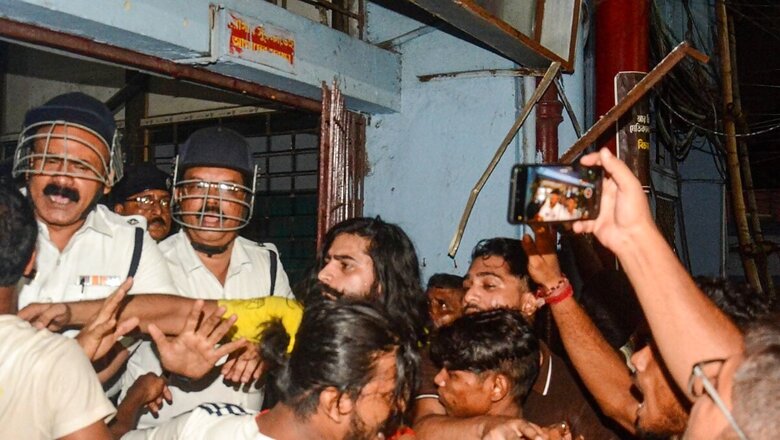
views
That the Police Commissioner of Kolkata—a post that carries considerable social and historical heft in that city—has come out swinging, defending the actions of the local police is telling. But even more telling is the fact that a rampaging mob was allowed by his men to swarm into RG Kar Hospital while thousands of residents of Kolkata were rallying peacefully to “reclaim the night" for women. Is Kolkata Police, set up in 1856, that incompetent? Surely not.
Yet, the Calcutta High Court obviously has serious reservations about the ability of this police force to thoroughly investigate the rape and murder of the young woman doctor that has convulsed the entire state. And it would seem that the Hon’ble justices had good reason to be sceptical after the scenes of chaos unfolded live on TV with the Kolkata Police unable and maybe even unwilling to contain the mayhem, putting a big question mark on their impartiality.
Had the media, national and local, not been present, the police and state authorities’ initial canard that the protestors rather than a mob with its own agenda had stormed the scene of the rape-murder of a doctor, may just have carried the day. Only, the mob even broke the stage and shelter erected by the protesting student-doctors of the medical college. That does not gel with the notion that the vandalism was done by a section of the peaceful protesters.
Cameras recorded that it was a mob of outsiders, using the night’s protest as an excuse to access the crime scene and vandalise it. And as students, protestors and even nursing staff of RG Kar have recounted (and recorded), the police did nothing as the mob ran amuck and even ran away. Strange behaviour from such an experienced police force. But the upshot is that any destruction of evidence there can now be blamed on “others" or denied altogether.
Curiously, there were some 300 rallies across the state—with echoes in other states in India—to “reclaim the night" and all of them passed off peacefully. Why then did mayhem break out only in one gathering—at the epicentre of the crime? Surely security should have been highest at ground zero? How could the state’s senior-most police and IAS officials present in the city not foresee—or even get prior information about a possible mob attack? Or did they?
It will be tough for the state government to convince viewers, and residents of Kolkata, that the city police were acting professionally. More so because there is a profound lack of trust in the police force, reinforced by recent incidents like Sandeshkhali. The fact that the National Crime Records Bureau anointed Kolkata as the safest city in 2023 for the third successive year is ironic indeed, and this incident points to a possible reason: the inaccurate recording of crimes.
The narrative of “the safest city in India" is eagerly amplified by misty-eyed non-resident Bengalis who remember some long-ago utopian city. Those who have lived in Kolkata and West Bengal in the past 20 years—bridging the time between the last years of the Communists and the ascent of the current ruling party—have a different view: the politicisation and partisanship of law enforcement has been an ongoing process, and this outrage was waiting to happen.
Ironically, some foresee a resurgence of the Left parties after this latest outrage. Those parties are counting on the public’s memory being conveniently short, and they may be proved right. The residents of West Bengal have been remarkably tolerant of deteriorating situations, forgiving unfulfilled promises of prosperity and progress, accepting rampant corruption, and willing to hero-worship the unworshippable. But can they afford to remain so acquiescent?
Given the link of the prime accused, Sanjay Roy, with Kolkata Police (without whose connivance he could not have functioned as a tout in the hospital with access to all areas at all times), the cops’ inability to stop the vandalism is definitely suspicious. Roy is not the only tout in that hospital; nor is RG Kar the only state-run hospital that has these “civic volunteers" engaged in nefarious activities, as countless patients and families have vouched.
So, who has allowed this system to persist and flourish, though the practice of co-opting party cadres into institutions started during the Communist rule? Why was the Chief Minister, who holds both the home and health portfolios, hurriedly insisting that the investigation was already 90 per cent complete? Why did she want this probe to stop with the arrest of one alleged perpetrator? Had the state police made honest efforts to find out who else may have been involved?
Heinous incidents of rape and murder have occurred in other states in India, and they have shaken the nation. Politicians of various parties have been accused of being involved in these crimes too. But in this case, many people in West Bengal now suspect a wider complicity of state authorities, including the police, in many murky goings-on in the hospital, and feel the brutal rape-murder of the postgraduate doctor on campus may be a consequence of this nexus.
Besides highlighting the abysmal lack of safety and security within the precincts of the hospital, the agitated doctors of RG Kar have also been recounting many questionable activities there. That is presumably why they had been demanding the removal of the principal. That functionary finally resigned but was promptly made principal of another government-run medical college by the state government, pointing to a special relationship with higher-ups.
In murder cases that become political hot potatoes, the destruction of evidence is all too familiar an accusation. Thanks to a shoddy police investigation and perjurous witnesses, a lower court decided that “No One Killed Jessica Lall" in New Delhi in 1999. Only a sustained campaign by the media and public led to the High Court convicting Manu Sharma and two others. Shockingly, one of the other two men was also convicted of another murder—of Nitish Katara, in 2002.
Neelam Katara’s relentless campaign for justice for her son, found beaten to death, his body burnt and left by the roadside, led to the conviction of the politically well-connected killer cousins Vikas and Vishal Yadav. She consistently asked for the death penalty as the case went up to the Supreme Court. It was not granted; the two got 25 years in jail without parole. But in Sharma and Yadavs’ cases, their political nexus was personal, not institutionalised.
Sanjay Roy is no political scion, just a lowly tout with godparents in the police and RG Kar administration. How did he have the gumption to attack a doctor within the premises of a hospital? Why was the police in such a hurry to brand him as the sole culprit once the suicide story was not accepted by the victim’s parents? Why did the mob vandalise the scene of the crime soon after a central police team was instructed by the High Court to take over the probe?
The doctor’s parents need to have Neelam Katara’s level of determination to ensure that the truth of their daughter’s brutal rape and murder—whether by one man or many—is uncovered, the noxious nexuses at play are exposed and justice is delivered. And after seeing the images of mayhem at RG Kar on 14 August 2024, the people of Bengal need to think about how long they will tolerate the gap between rhetoric and reality, between promises and practice.
The author is a freelance writer. Views expressed in the above piece are personal and solely those of the author. They do not necessarily reflect News18’s views.




















Comments
0 comment